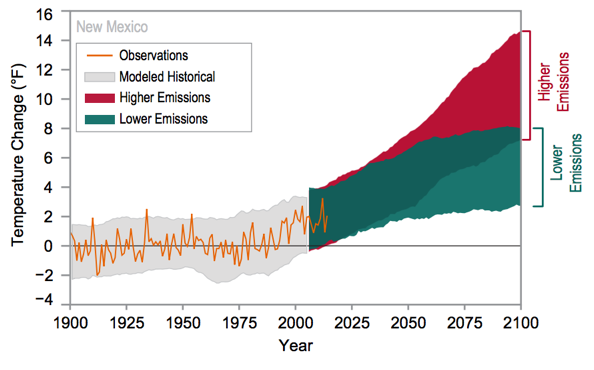Global Warming: How it affects New Mexico

March 8, 2017
Global Warming has been a topic of concern for country leaders for the last 25 years. There is no way around the fact that temperatures are rising in the United States and worldwide, but has it impacted the State of New Mexico? Per the National Centers of Environmental Information, the average annual temperature has increased 2 degrees in New Mexico since 1970. Historically unprecedented future warming is likely and droughts in the region will likely increase, while snow-pack accumulation should decrease.
Dr. Dan Dugas, a professor at New Mexico State University in the Department of Geography since 1996, is familiar with the southwestern climate, believes that climate change is upon us and is much more than just warmer days.
“Certainly one can say from the scientific community and the vast general consensus is that global warming is happening we are experiencing climate change,” Dugas explained. “The reason for that is amongst the scientific community, there is belief that humans have had a role to play. The increase in carbon dioxide and other greenhouse gases allow for there to be higher levels of energy from the Sun, so it’s not just a temperature thing. It’s an increase of energy from the Sun that influences droughts, floods, hurricanes, and ocean temperatures.”
The average monthly high in February in Las Cruces is 64 degrees but the temperature cleared the 70 degree plateau a record nine times last month (twice reaching 80 degrees). Precipitation varies from year to year, but the driest eras in New Mexico were in the early 1950’s and the 2010’s. Because of this recent trend of below-average yearly precipitation totals, the Elephant Butte Reservoir water levels have steadily declined.
The lack of rain also shakes up the ecosystem of the Chihuahuan Desert. Extreme drought causes grasslands to die, and the grasslands were a food resource for wild livestock. Increasing temperatures also causes evaporation in moist and vegetated surfaces.
“Climate change is just so much more than being able to bust out the tank tops and shorts earlier than during Spring Break,” Alex Montoya, a 23-year-old Environmental Science major said. “I actually went on an internship and lived in the Gila National Mountains for a summer and saw first-hand what hotter-than-normal temperatures do to insects and animals. They are engineered to do certain things once the climate starts acting a certain way, and when it doesn’t get cold when it should, coyotes and bears for example will begin to starve because they cannot find the resources they would usually find.”
Projections predict that during the spring season, which is already dry, New Mexico will see even more of a decline in rainfall. Coupled with warmer temperatures, this harms snow-pack rain. Less snow, which melts quicker, means less water in rivers during the summer months, when farmers need that water for crops like cotton, pecans and chilé. Changes in irrigation would need to be made even if there was not a decline in snow, because the hotter temperatures cause the snow to melt before it usually does.
Climate change is here according to the statistics and scientists, and it will be up to this generation to slow down what could permanently harm our only home forever.

